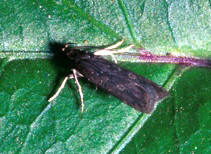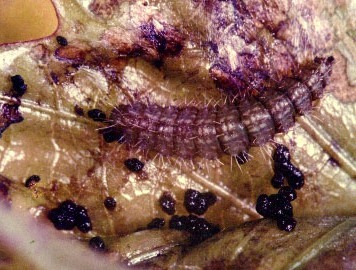|
Class |
Insecta |
|
Order |
Lepidoptera |
|
Family |
B.
convolvuli - Gelechiidae
O.
concursa - Pyralidae
H.
hipponalis - Pyralidae |
Leaffolders are considered important defoliators of sweetpotato.
Black and green leaffolders are widespread throughout Asia and Africa and
brown leaffolder has only been reported in the Philippines.
Green and black leaffolders
The larvae of these two leaffolders fold the leaf, with the folded area
showing some webbing. Then they feed between the folded leaf blade. The young
larva feeds on the upper leaf surface leaving the lower epidermis intact. As the
larvae mature, they eat through the leaf blade producing
lace-like holes with the main veins remaining intact.
Folds are usually
single, but sometimes two folds are made, or two leaves are joined together. The holes
produced by green leaffolder are generally bigger than those produced by the black leaffolder.
The feeding area
may turn brown and is littered with blackish excreta (frass).
Brown leaffolder
Brown leaffolder attacks the shoots and feeds inside the unopened leaves. The
young larva feeds on the upper leaf surface leaving the lower epidermis intact.
The damaged tissue may turn brown in response to the injury. Blackish
frass is present and a good indicator that the damage was caused by a
caterpillar. As the larva matures, it eats right through the leaf blade
producing irregular holes on the young expanding leaves.
Black leaffolder
Egg. The eggs are oval, yellowish white when newly laid and turn
pinkish yellow when about to hatch.
Larva. Newly hatched larvae are
whitish at first turning greenish yellow later without any markings. Markings
appear only in the second instar with distinct black and white marks appearing
on the head, thorax and first and second abdominal segments. The later instars
retain the black markings which become larger and more prominent as the larvae
mature. Full-grown larvae measure about 15 mm.
Pupa. The pupae of the black
leaffolder are about 7 mm, yellowish brown at first turning dark golden brown
later. They have a tuft of hairs at the tip of the abdomen and are
enclosed in scanty cocoon.
Adult. The adults are grayish
black moths, 8 mm long, with scattering of white scales on the body and
appendages.
Green leaffolder
Egg. The eggs are shiny green, oblong, and covered with a scale-like
gelatinous material.
Larva. The larvae are light yellow with dark brown head. A dark brown
sclerite appears on the dorsal part of the prothorax in the second instar which
becomes divided and appears circular. The body of the later instars turns darker
green and the integument appears moist and waxy. Full-grown larvae measure 13
mm.
Pupa. The obtect pupae are yellowish white at first and turn reddish
brown. The abdomen tapers anteriorly and has distinct constriction.
Adult. The adults are yellowish brown with dark brown markings on the
wings.
Brown leaffolder
Egg. The eggs are oblong and brownish yellow.
Larva. The body of the larva is green which turns brownish as it matures.
The head is greenish with brownish tinge. The body is covered with short white
setae, 2 pairs of slightly longer setae per segment, prothorax with anteriorly
directed setae. The different instars have similar markings and colouration but
differ only in size. Full-grown larvae measure 5 mm.
Pupa. Ventral part of the pupa is light green while the dorsal part is
brown. The mid-dorsal region is sharply ridged and the anterior part of the
abdomen is covered with setae. Just before adult emergence, wing part turns
brown with darker brown markings. Length of pupa is 6.5 mm.
Adult. The adults are dark brown moths (4.5-5 mm) with brown head and
long light brown antenna. The wings are brown with light brown markings. The
entire margin of the wings has dense long hair.
|

Black leaffolder larva
(A. Braun).
|

Black leaffolder adult
(A. Braun).
|
|

Green leaffolder larva (J.
O'Sullivan).
|

Green leaffolder adult
(A. Braun).
|
|

Brown leaffolder larva (E.
Vasquez).
|

Brown leaffolder adult (E.
Vasquez).
|
Black leaffolder
The eggs are laid singly along the veins on the underside of the
leaf or on the terminal shoots. Incubation period is about 3-5 days. The insect
undergoes five larval instars for a period of 2-5 days for each instar. A newly
hatched larva is whitish at first. The average total larval period is eleven
days. The pupal period is 4-7 days. A female moth lays an average of 44 eggs and
lives an average of five days.
Green leaffolder
The female lays an average of 90 eggs per day for three days.
The eggs are laid singly or in groups on the upper surface of the leaf, usually
near the midrib. Incubation period lasts for 3-6 days. Like the black leaffolder,
the first and second instar larvae do not fold the leaf margin. Only the third
and later instars fold the leaf margins together using silk threads they spin.
The green leaffolder undergoes five larval instars which lasts from 16-31 days.
The pupal period lasts from 4-8 days.
Brown leaffolder
The eggs are laid singly along the veins on the shoots,
especially on very young unopened leaves. Sometimes eggs are observed on the
petiole of the shoots. The female lays 2-10 eggs in seven days. The eggs hatch
4-5 days after oviposition. The insect undergoes five larval instars lasting
from 2-4 days per instar. The total larval period ranges from 9-17 days.
Pupation lasts for 5-6 days. The duration from egg-laying to adult emergence
ranges from 18-27 days. Longevity of adults lasts from 2-7 days.
Beside sweetpotato, the black leaffolder can complete its
development only on two Ipomoea species, Ipomoea triloba and I.
aquatica and on a weed, Mikania cordata (Burm. F.) B. L. Robinson (Asteraceae).
Alternate hosts of the brown leaffolder include Ipomea
triloba and I. aquatica.
The green leaffolder can only complete its development on
Ipomea triloba, I. purpurea, I aquatica, I. pes-caprae and Mikania
cordata.
Cultural control
Use
of insect-free planting materials.
|

A pentatomid bug (Hemiptera) which preys on leaffolder larvae (E.
Vasquez). |
A
species of earwig (Order Dermaptera) and an ichneumonid parasite, Macrocentrus
sp. attack the larvae of black leaffolder in the field. Macrocentrus
sp. attacks young larvae when they have not yet folded the leaf margins.
A
hymenopterous parasite, Brachymeria sp., attacks the brown leaffolder
pupa.
Two
species of hymenopterous parasites Brachymeria sp. and a chalchid
wasp attack the green leaffolder pupae and another unidentified species
parasitises the larvae.
Chemical
control
If
level of infestation warrants the use of chemicals, then contact-systemic
insecticides can be applied.
Amalin,
D.M. and Vasquez, E. A. 1993. A handbook on Philippine sweetpotato pests and
their natural enemies. International Potato Center (CIP), Los Baños,
Philippines. 82 p.
Ames,
T., Smit, N.E.J.M., Braun, A.R., O’Sullivan, J.N., and Skoglund, L.G. 1996.
Sweetpotato: Major pests diseases, and nutritional disorders. International
Potato Center (CIP). Lima, Perú. 152 p.
Gapasin,
D.P. 1981. Biological studies of sweetpotato insect pests and their natural
enemies. Terminal Report. A research study funded by the Philippine Council for
Agriculture and Resources Research (PCARR). Department of Plant Protection,
Visayas State College of Agriculture. 210 p.
Gapasin,
D.P. and Rebadulla, L.Z. 1981. Biology of the black and green leaffolders
of Sweetpotato. Ann. Trop. Res. 3: 37-50.
PANS.
1978. Pest Control in Tropical Root Crop. Manual No. 4. Center for Overseas Pest
Research. London 235 p.
Vasquez,
E.A. and Sajise, C.E. 1990. Pests of sweetpotato: Insects, mites and diseases.
Philippine Root Crop Information Service, Philippine Root Crop Research &
Training Center. 65 p.
Contributed
by: Erlinda Vasquez
and
Vilma Amante
|

